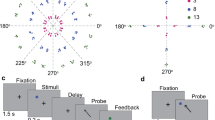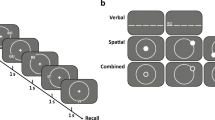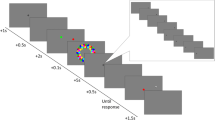Abstract
Visuospatial working memory (VSWM) is a set of cognitive processes used to encode, maintain and manipulate spatial information. One important feature of VSWM is that it has a limited capacity such that only few items can be actively stored and manipulated simultaneously. Given the limited capacity, it is important to determine the conditions that affect memory performance as this will improve our understanding of the architecture and function of VSWM. Previous studies have shown that VSWM is disrupted when task-irrelevant eye movements are performed during the maintenance phase; however, relatively fewer studies examined the role of eye movements performed during the encoding phase. On one hand, performing eye movements during the encoding phase could result in a stronger memory trace because the memory formation is reinforced by the activation of the motor system. On the other hand, performing eye movements to each target could disrupt the configural processing of the spatial array because the spatial representation has to be updated with each movement to maintain perceptual stability. Therefore, this work was conducted to examine whether task-relevant saccadic eye movements performed during the encoding phase of a visuospatial working memory task affect the recall of serially presented targets. Results from two experiments showed that average recall accuracy was significantly higher when the spatial array (set size ≥ 7) was encoded using a covert strategy—that is, while participants fixated on a central target, in comparison to an overt strategy—that is, while participants moved their eyes to fixate on each target. Furthermore, the improvement in accuracy was evident only for targets presented in the first half of the sequence, suggesting that the primacy effect is modulated by the presence of eye movements. We propose that executing saccades during encoding could interfere with the ability to use a chunking strategy or disrupt active visualization of the configuration. In conclusion, this is the first study to show that task-relevant saccadic eye movements performed during encoding may actually reduce the spatial span of VSWM. These results extend the current knowledge about the role of eye movements in VSWM, and have implications for future studies investigating the VSWM.




Similar content being viewed by others
References
Alichniewicz KK, Brunner F, Klunemann HH, Greenlee MW (2012) Structural and functional neural correlates of visuospatial information processing in normal aging and amnestic mild cognitive impairment. Neurobiol Aging 33:2782–2797
Allport A (1989) Visual attention. In: Posner MI (ed) Foundations of cognitive sciences. MIT Press, Cambridge, pp 631–682
Awh E, Armstrong KM, Moore T (2006) Visual and oculomotor selection: links, causes and implications for spatial attention. Trends Cogn Sci 10:124–130
Baddeley A (1986) Working memory. Academic Press, New York
Baddeley A (2003) Working memory: looking back and looking forward. Nat Rev Neurosci 4:829–839
Bays PM, Husain M (2008) Dynamic shifts of limited working memory resources in human vision. Science 321:851–854
Berch DB, Krikorian R, Huha EM (1998) The Corsi block-tapping task: methodological and theoretical considerations. Brain Cogn 38:317–338
Bianchini F, Di Vita A, Palermo L, Piccardi L, Blundo C, Guariglia C (2014) A selective egocentric topographical working memory deficit in the early stages of Alzheimer’s disease: a preliminary study. Am J Alzheimers Dis Other Demen 29:749–754
Bo J, Seidler RD (2009) Visuospatial working memory capacity predicts the organization of acquired explicit motor sequences. J Neurophysiol 101:3116–3125
Bo J, Borza V, Seidler RD (2009) Age-related declines in visuospatial working memory correlate with deficits in explicit motor sequence learning. J Neurophysiol 102:2744–2754
Bor D, Duncan J, Wiseman RJ, Owen AM (2003) Encoding strategies dissociate prefrontal activity from working memory demand. Neuron 37:361–367
Brooks LR (1967) The suppression of visualization by reading. Q J Exp Psychol A 19:289–299
Busch RM, Farrell K, Lisdahl-Medina K, Krikorian R (2005) Corsi Block-Tapping task performance as a function of path configuration. J Clin Exp Neuropsychol 27:127–134
Chum M, Bekkering H, Dodd MD, Pratt J (2007) Motor and visual codes interact to facilitate visuospatial memory performance. Psychon Bull Rev 14:1189–1193
Cowan N (2001) The magical number 4 in short-term memory: a reconsideration of mental storage capacity. Behav Brain Sci 24:87–114 (discussion 114–185)
Dent K, Smyth MM (2006) Capacity limitations and representational shifts in spatial short-term memory. Vis Cognit 13:529–572
Dettwiler A, Murugavel M, Putukian M, Cubon V, Furtado J, Osherson D (2014) Persistent differences in patterns of brain activation after sports-related concussion: a longitudinal functional magnetic resonance imaging study. J Neurotrauma 31:180–188
Dodd MD, Shumborski S (2009) Examining the influence of action on spatial working memory: the importance of selection. Q J Exp Psychol (Hove) 62:1236–1247
Farrell Pagulayan K, Busch RM, Medina KL, Bartok JA, Krikorian R (2006) Developmental normative data for the Corsi Block-tapping task. J Clin Exp Neuropsychol 28:1043–1052
Fukuda K, Awh E, Vogel EK (2010) Discrete capacity limits in visual working memory. Curr Opin Neurobiol 20:177–182
Gao Z, Gao Q, Tang N, Shui R, Shen M (2015) Organization principles in visual working memory: evidence from sequential stimulus display. Cognition 146:277–288
Godijn R, Theeuwes J (2012) Overt is no better than covert when rehearsing visuo-spatial information in working memory. Mem Cognit 40:52–61
Golomb JD, Kanwisher N (2012) Retinotopic memory is more precise than spatiotopic memory. Proc Natl Acad Sci USA 109:1796–1801
Guerard K, Tremblay S (2012) The effect of path length and display size on memory for spatial information. Exp Psychol 59:147–152
Hayhoe M, Lachter J, Feldman J (1991) Integration of form across saccadic eye movements. Perception 20:393–402
Huebner GM, Gegenfurtner KR (2010) Effects of viewing time, fixations, and viewing strategies on visual memory for briefly presented natural objects. Q J Exp Psychol (Hove) 63:1398–1413
Huntley JD, Howard RJ (2010) Working memory in early Alzheimer’s disease: a neuropsychological review. Int J Geriatr Psychiatry 25:121–132
Irwin DE (1996) Integrating information across saccadic eye movements. Curr Dir Psychol 5:94–100
Irwin DE, Zelinksky GJ (2002) Eye movements and scence perception: memory for things observed. Percept Psychophys 64:882–895
Jiang Y, Olson IR, Chun MM (2000) Organization of visual short-term memory. J Exp Psychol Learn Mem Cogn 26:683–702
Kessels RP, van Zandvoort MJ, Postma A, Kappelle LJ, de Haan EH (2000) The Corsi block-tapping task: standardization and normative data. Appl Neuropsychol 7:252–258
Lawrence BM, Myerson J, Oonk HM, Abrams RA (2001) The effects of eye and limb movements on working memory. Memory 9:433–444
Lawrence BM, Myerson J, Abrams RA (2004) Interference with spatial working memory: an eye movement is more than a shift of attention. Psychon Bull Rev 11:488–494
Luck SJ, Vogel EK (1997) The capacity of visual working memory for features and conjunctions. Nature 390:279–281
Mitrushina M, Boone KB, Razani J, D’Elia LF (2005) Handbook of normative data for neuropsychological assessment. Oxford University Press, New York
Orsini A, Simonetta S, Marmorato MS (2004) Corsi’s block-tapping test: some characteristics of the spatial path which influence memory. Percept Mot Skills 98:382–388
Ouwehand K, van Gog T, Paas F (2016) Compensatory effects of pointing and predictive cueing on age-related declines in visuospatial working memory. Mem Cognit 44:950–965
Parmentier FB, Elford G, Mayberry M (2005) Transitional information in spatial serial memory: path characteristics affect recall performance. J Exp Psychol Learn Mem Cogn 31:412–427
Patt VM, Thomas ML, Minassian A, Geyer MA, Brown GG, Perry W (2014) Disentangling working memory processes during spatial span assessment: a modeling analysis of preferred eye movement strategies. J Clin Exp Neuropsychol 36:186–204
Pearson D, Sahraie A (2003) Oculomotor control and the maintenance of spatially and temporally distributed events in visuo-spatial working memory. Q J Exp Psychol A 56:1089–1111
Peterson DJ, Berryhill ME (2013) The Gestalt principle of similarity benefits visual working memory. Psychon Bull Rev 20:1282–1289
Phillips WA (1983) Short term visual memory. Philos Trans R Soc Lond B Biol Sci 302:295–309
Postle BR, Idzikowski C, Sala SD, Logie RH, Baddeley AD (2006) The selective disruption of spatial working memory by eye movements. Q J Exp Psychol (Hove) 59: 100–120
Prime SL, Tsotsos L, Keith GP, Crawford JD (2007) Visual memory capacity in transsaccadic integration. Exp Brain Res 180:609–628
Prime SL, Vesia M, Crawford JD (2011) Cortical mechanisms for trans-saccadic memory and integration of multiple object features. Philos Trans R Soc Lond B Biol Sci 366:540–553
Pylyshyn Z (2001) Visual indexes, preconceptual objects and situated vision. Cognition 80:127–158
Repovs G, Baddeley A (2006) The multi-component model of working memory: explorations in experimental cognitive psychology. Neuroscience 139:5–21
Saint-Aubin J, Tremblay S, Jalbert A (2007) Eye movements and serial memory for visual-spatial information: does time spent fixating contribute to recall? Exp Psychol 54:264–272
Salthouse TA, Babcock RL (1991) Decomposing adut age differnces in working memory. Dev Psychol 27:763–776
Sapkota RP, Pardhan S, van der Linde I (2011) The impact of extrafoveal information on visual short-term memory for object position. Journal of Cognitive Psychology 23:574–585
Smirni P, Villardita C, Zappala G (1983) Influence of different paths on spatial memory performance in the Block-Tapping Test. J Clin Neuropsychol 5:355–359
Smyth MM, Pearson NA, Pendleton LR (1988) Movement and working memory: patterns and positions in space. Q J Exp Psychol A 40:497–514
Theeuwes J, Belopolsky A, Olivers CN (2009) Interactions between working memory, attention and eye movements. Acta Psychol (Amst) 132:106–114
Tremblay S, Saint-Aubin J, Jalbert A (2006) Rehearsal in serial memory for visual-spatial information: evidence from eye movements. Psychon Bull Rev 13:452–457
Woodman GF, Vecera SP, Luck SJ (2003) Perceptual organization influences visual working memory. Psychon Bull Rev 10:80–87
Xu Y (2008) Representing connected and disconnected shapes in human inferior intraparietal sulcus. Neuroimage 40:1849–1856
Zelinksky GJ, Loschky LC (2005) Eye movements serialize memory for objects in scenes. Percept Psychophys 67:676–690
Acknowledgements
This work was supported by the Natural Sciences and Engineering Research Council of Canada (NSERC) Undergraduate Student Research Awards (USRA) awarded to LM.
Author information
Authors and Affiliations
Corresponding author
Rights and permissions
About this article
Cite this article
Martin, L., Tapper, A., Gonzalez, D.A. et al. The effects of task-relevant saccadic eye movements performed during the encoding of a serial sequence on visuospatial memory performance. Exp Brain Res 235, 1519–1529 (2017). https://doi.org/10.1007/s00221-017-4915-6
Received:
Accepted:
Published:
Issue Date:
DOI: https://doi.org/10.1007/s00221-017-4915-6




